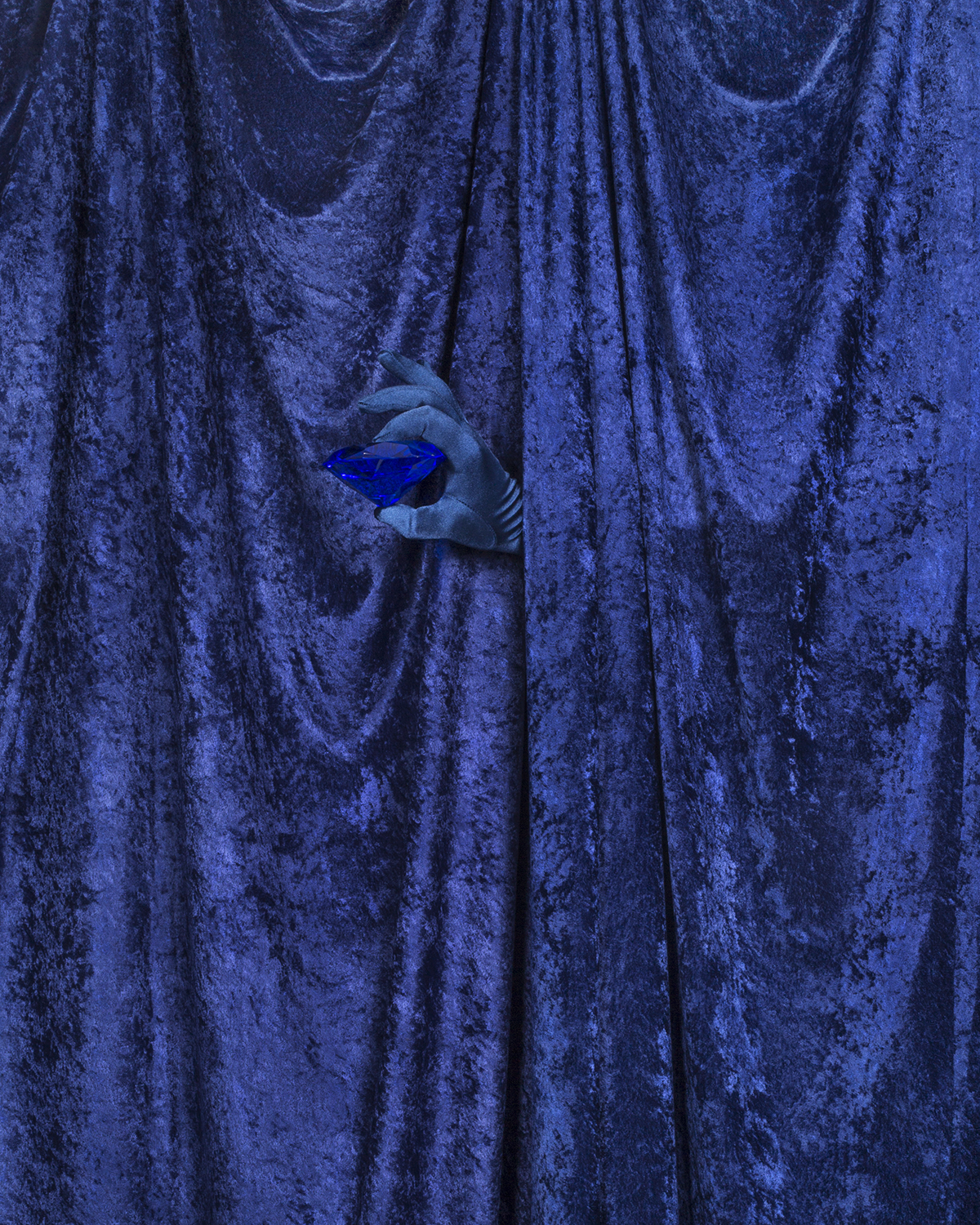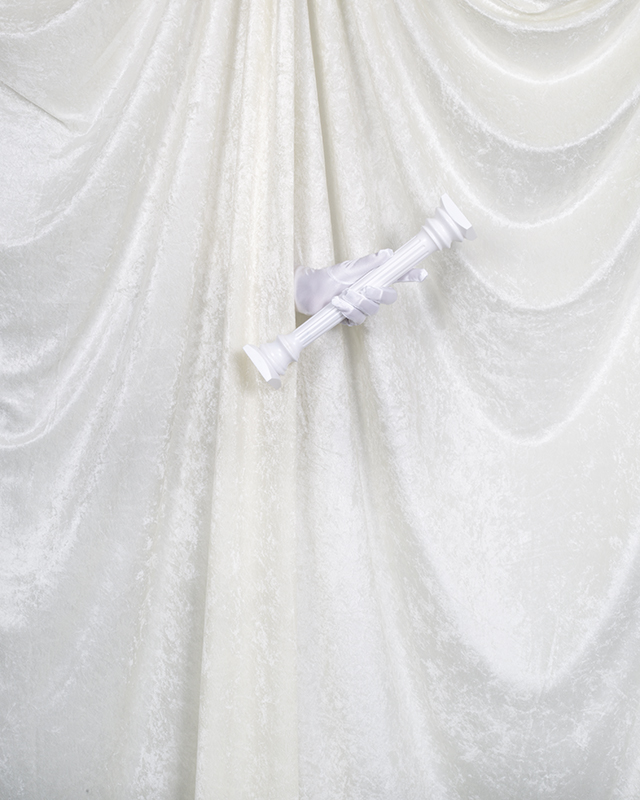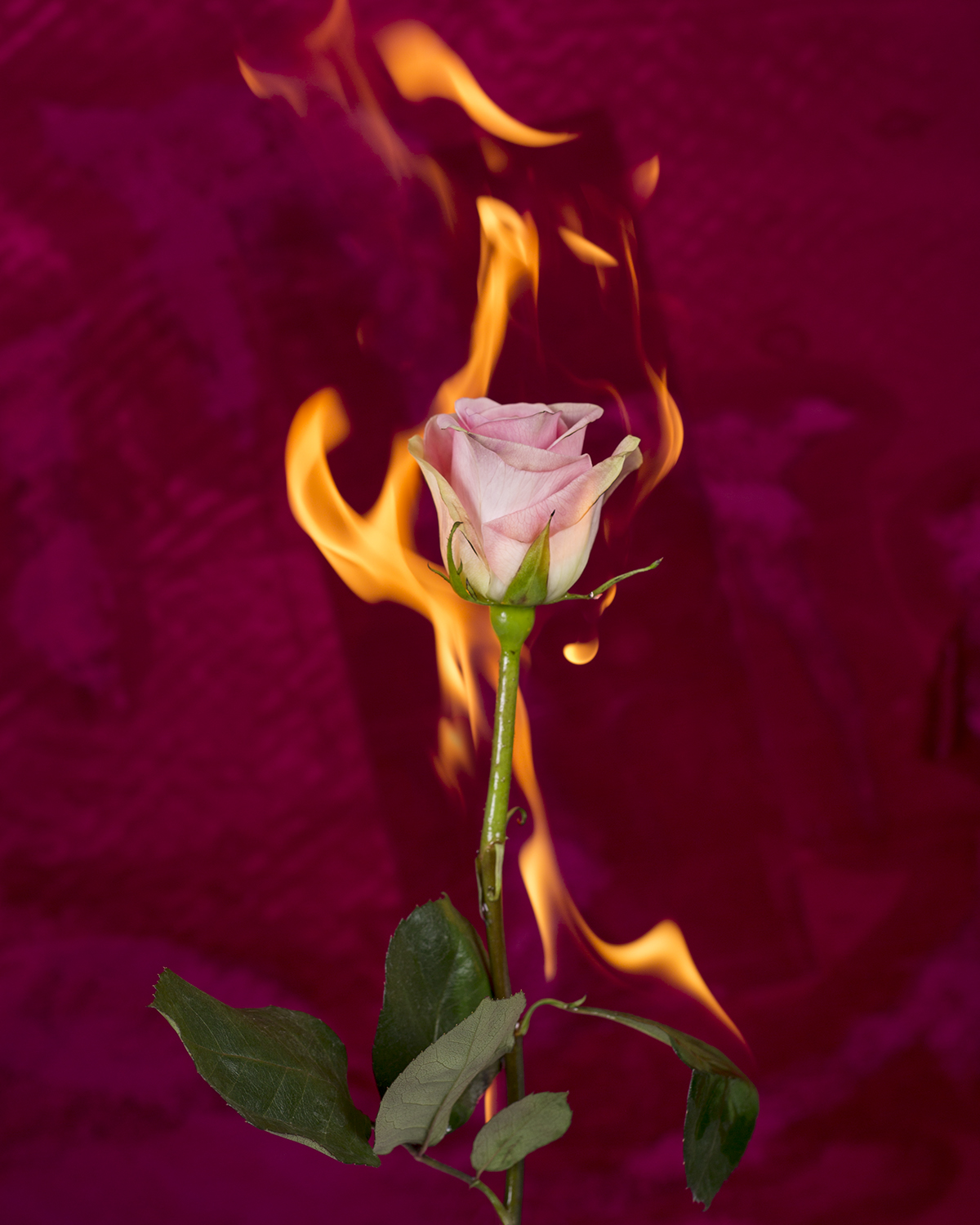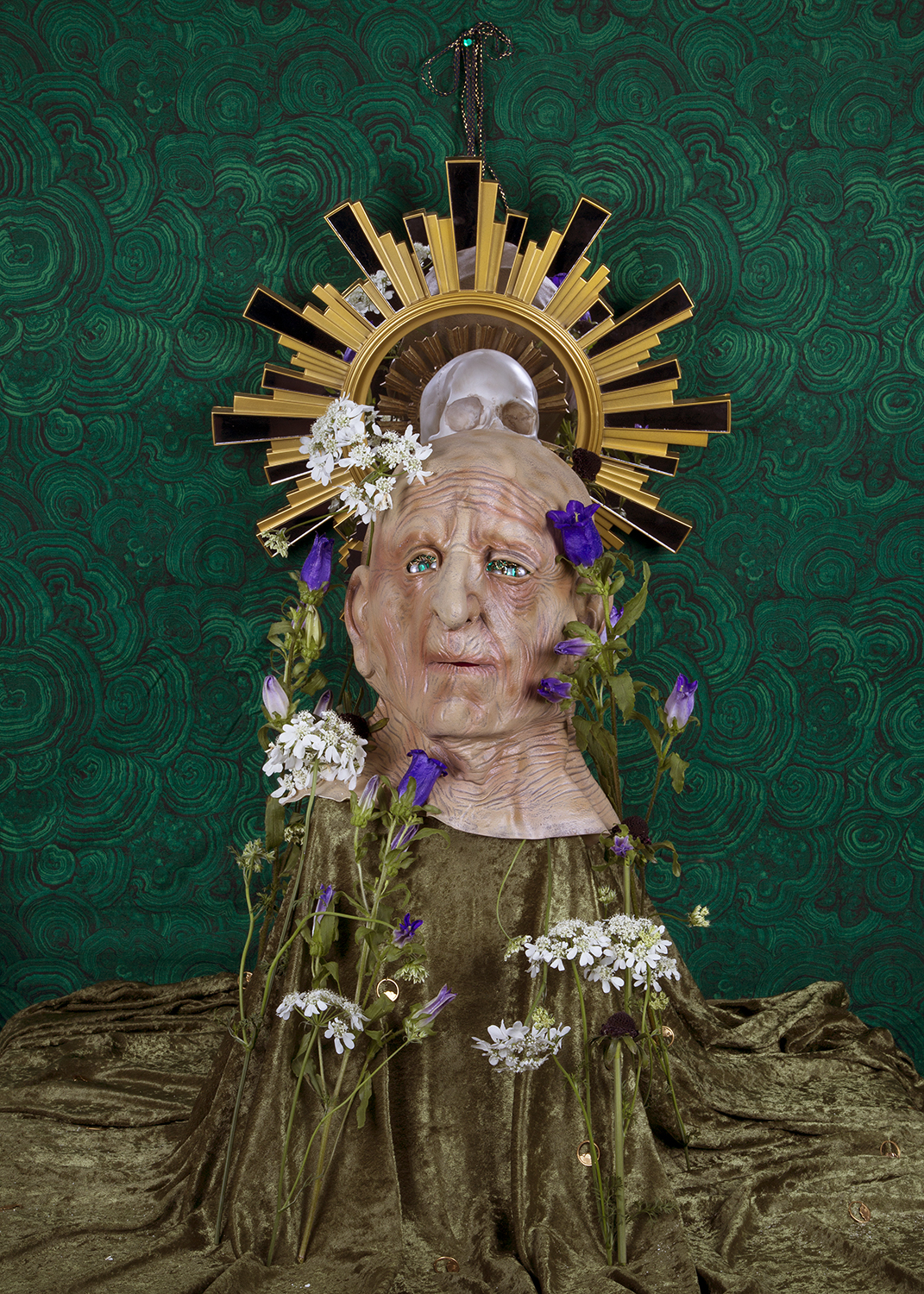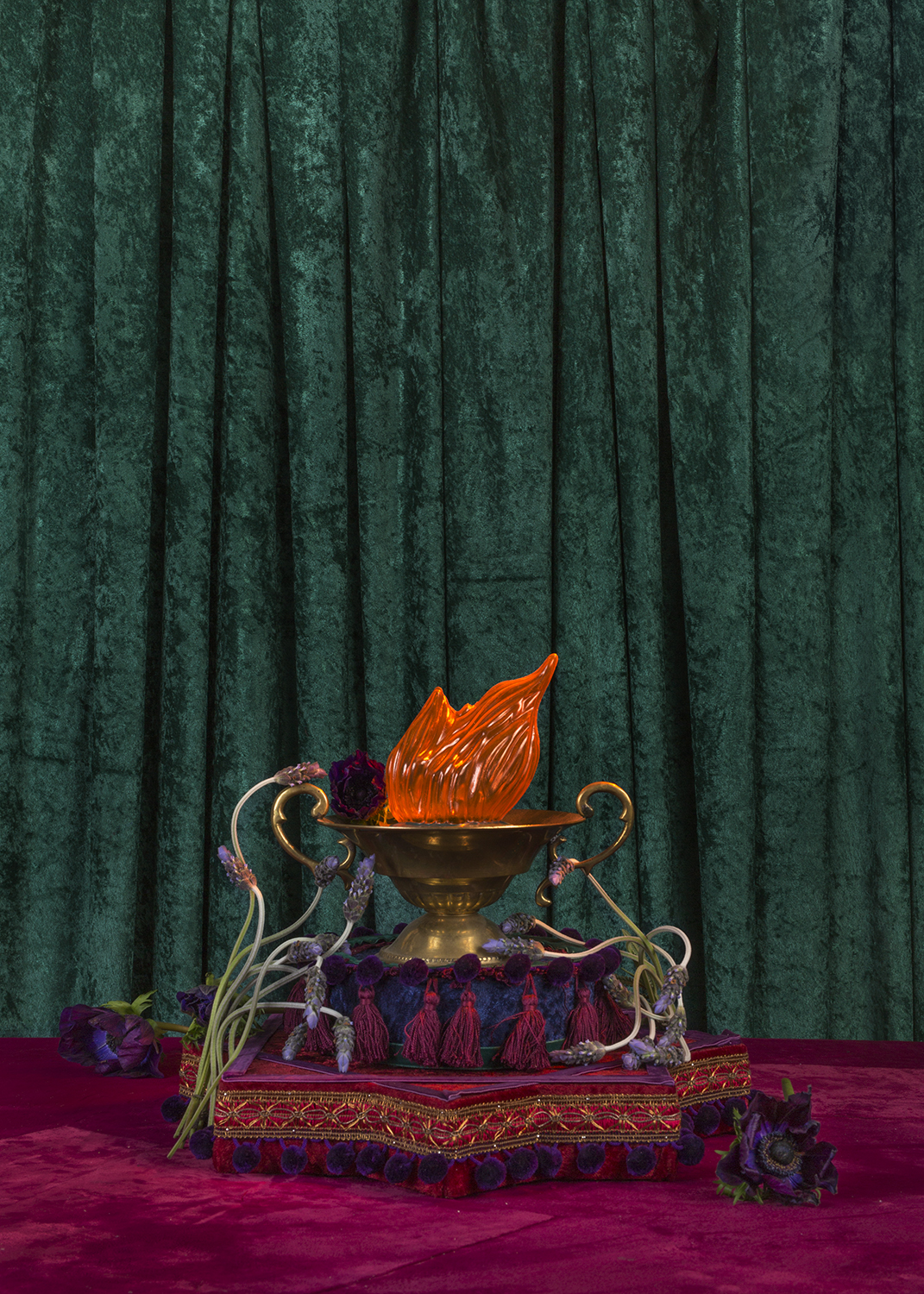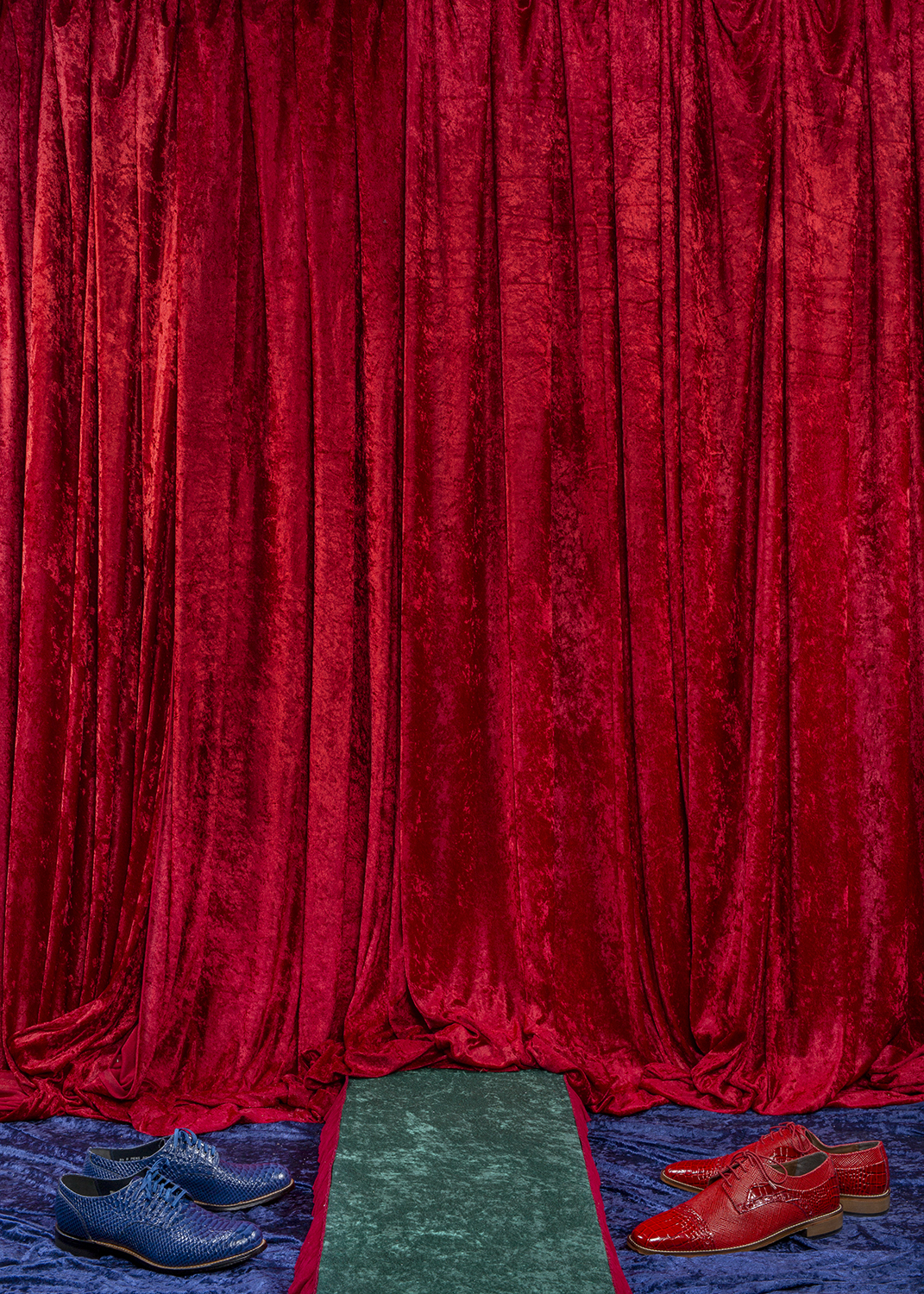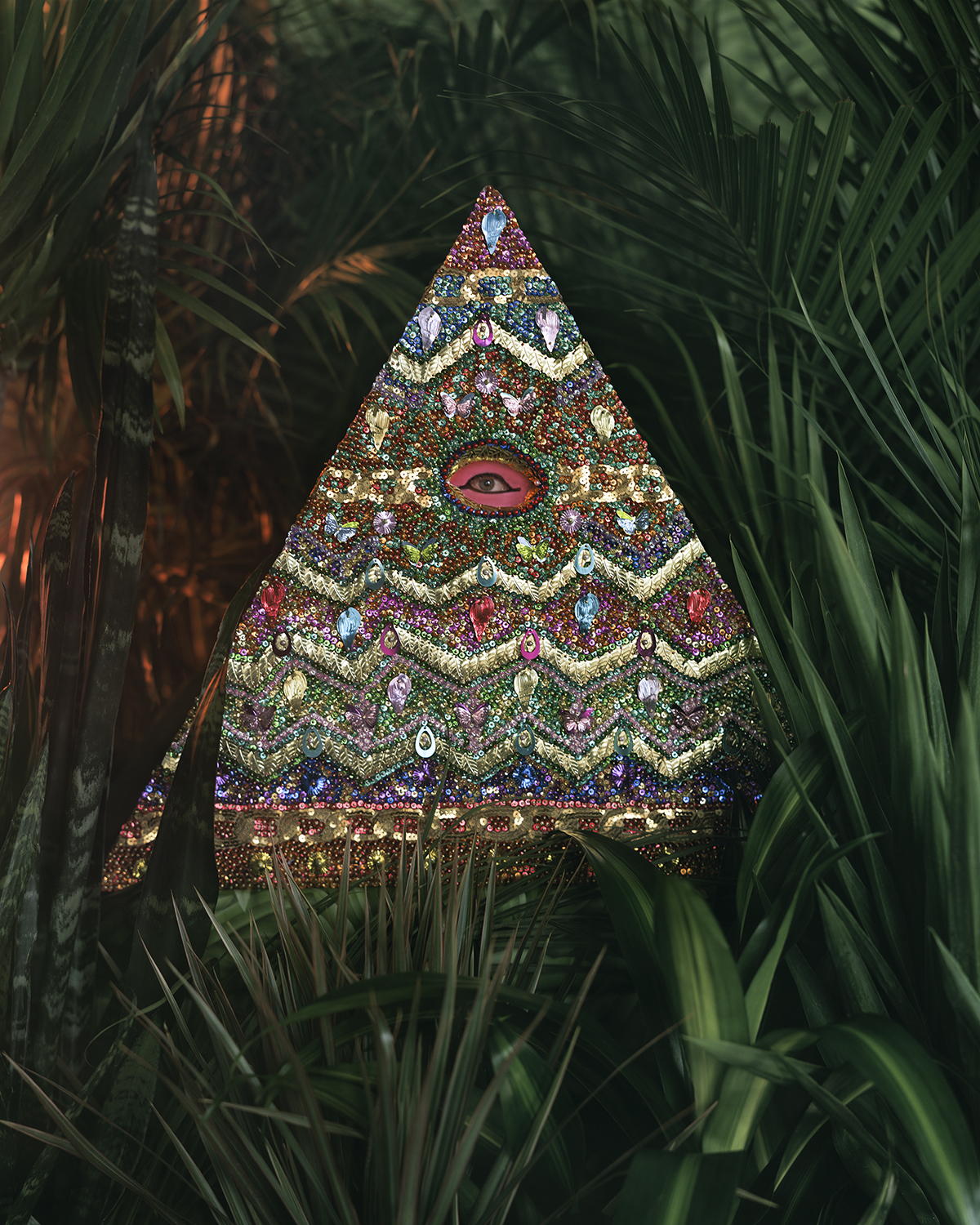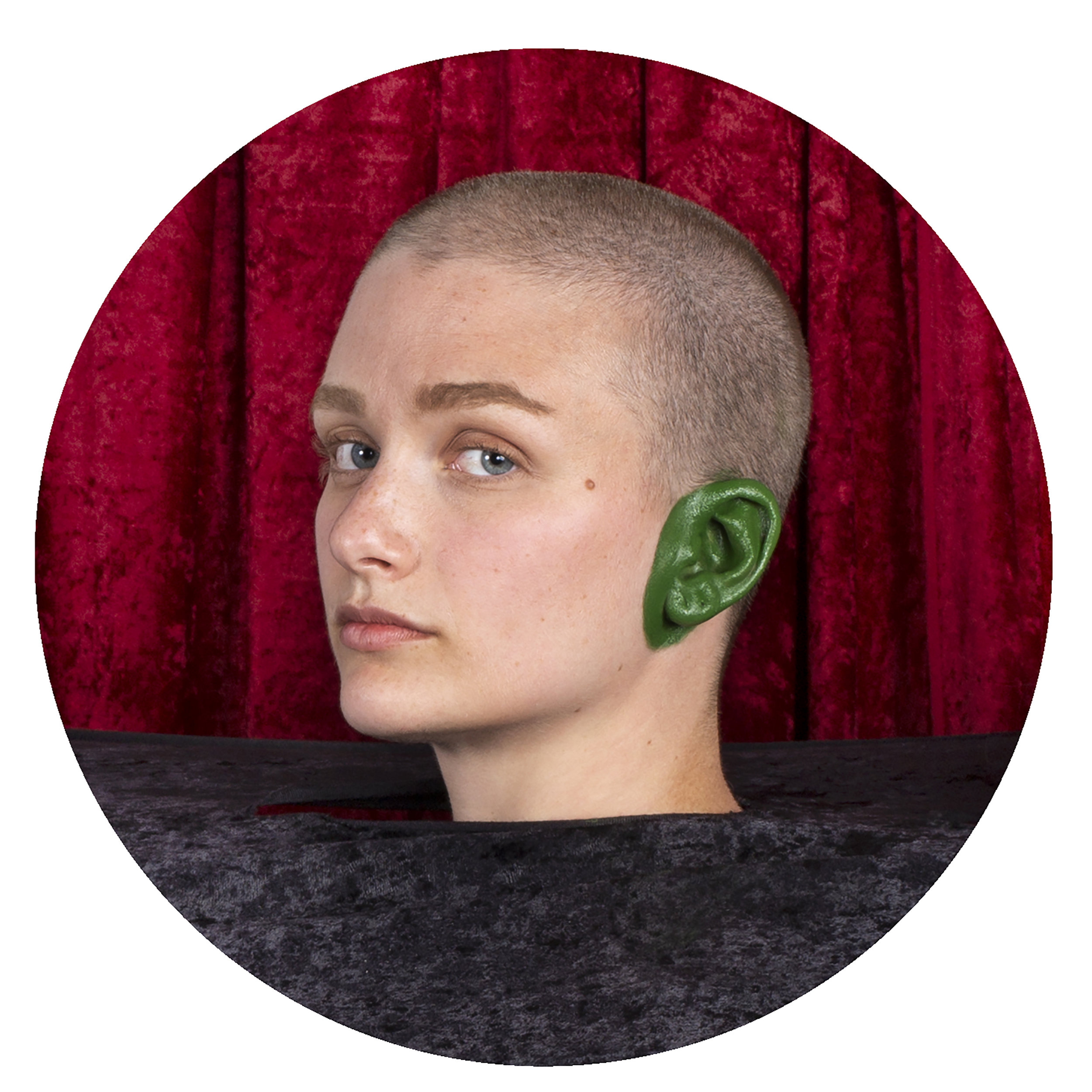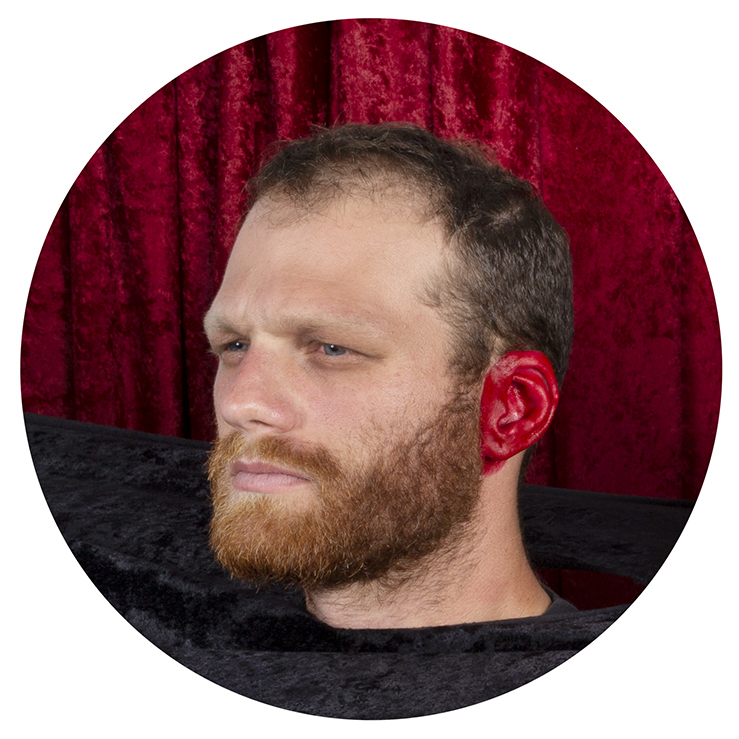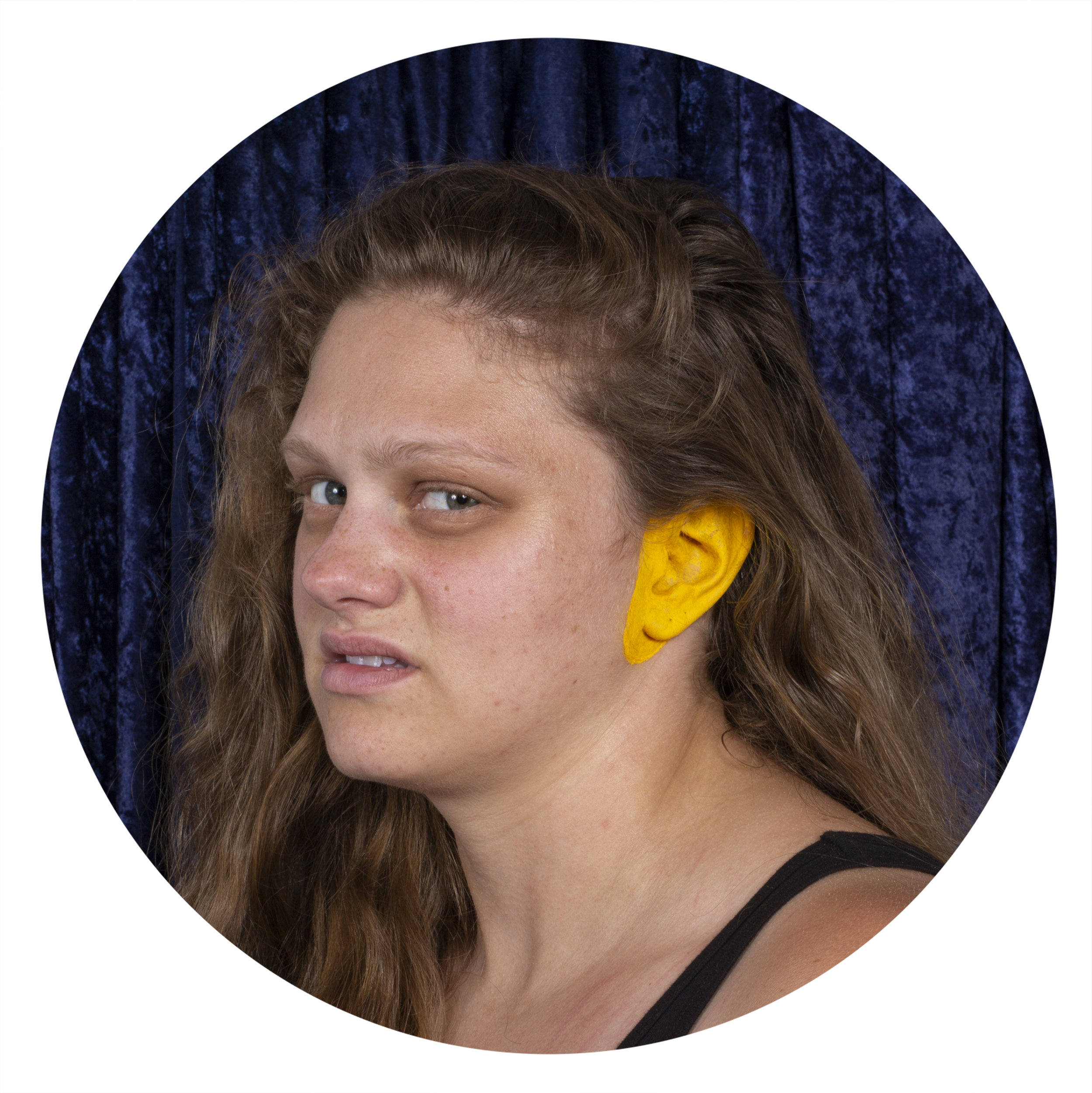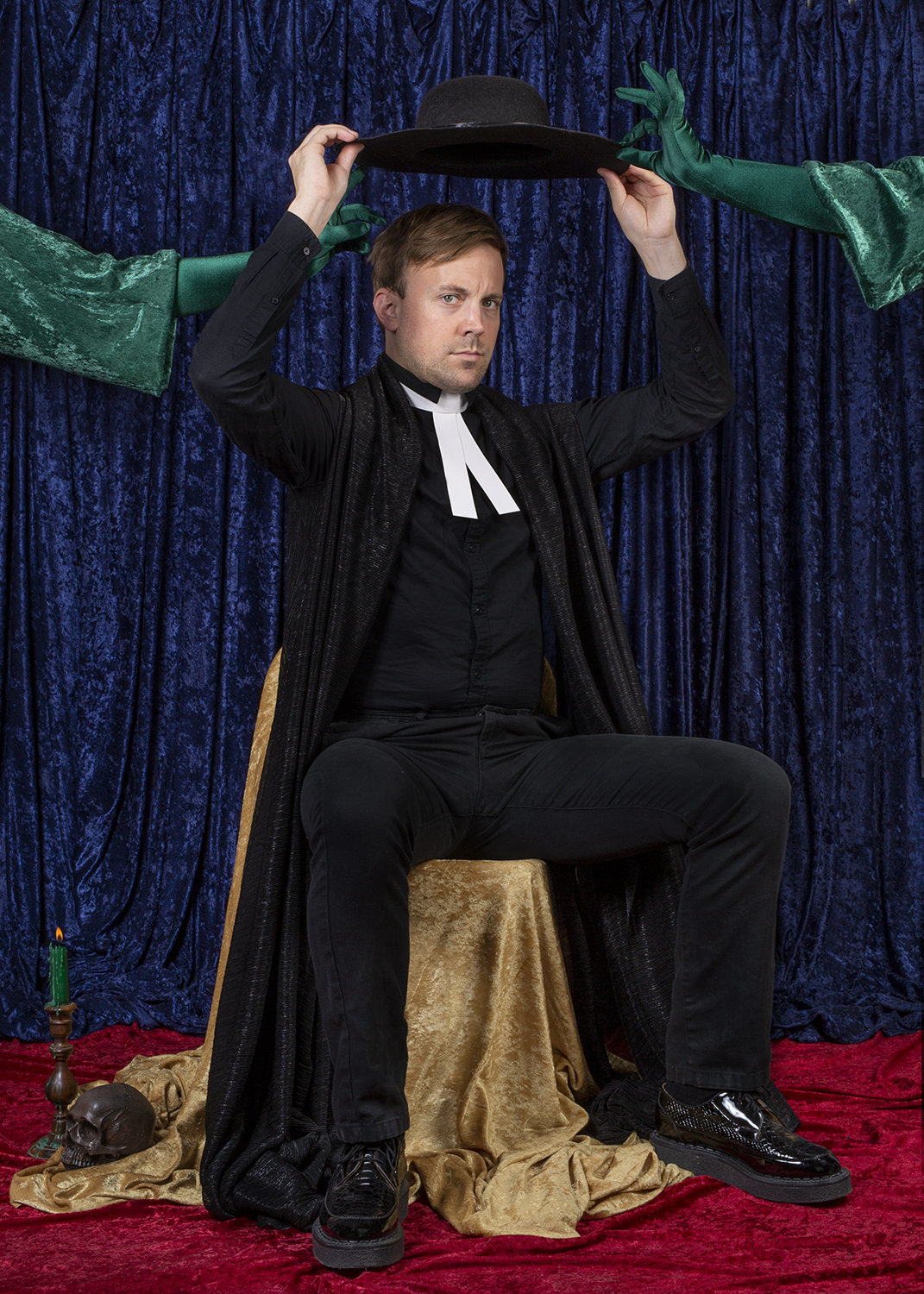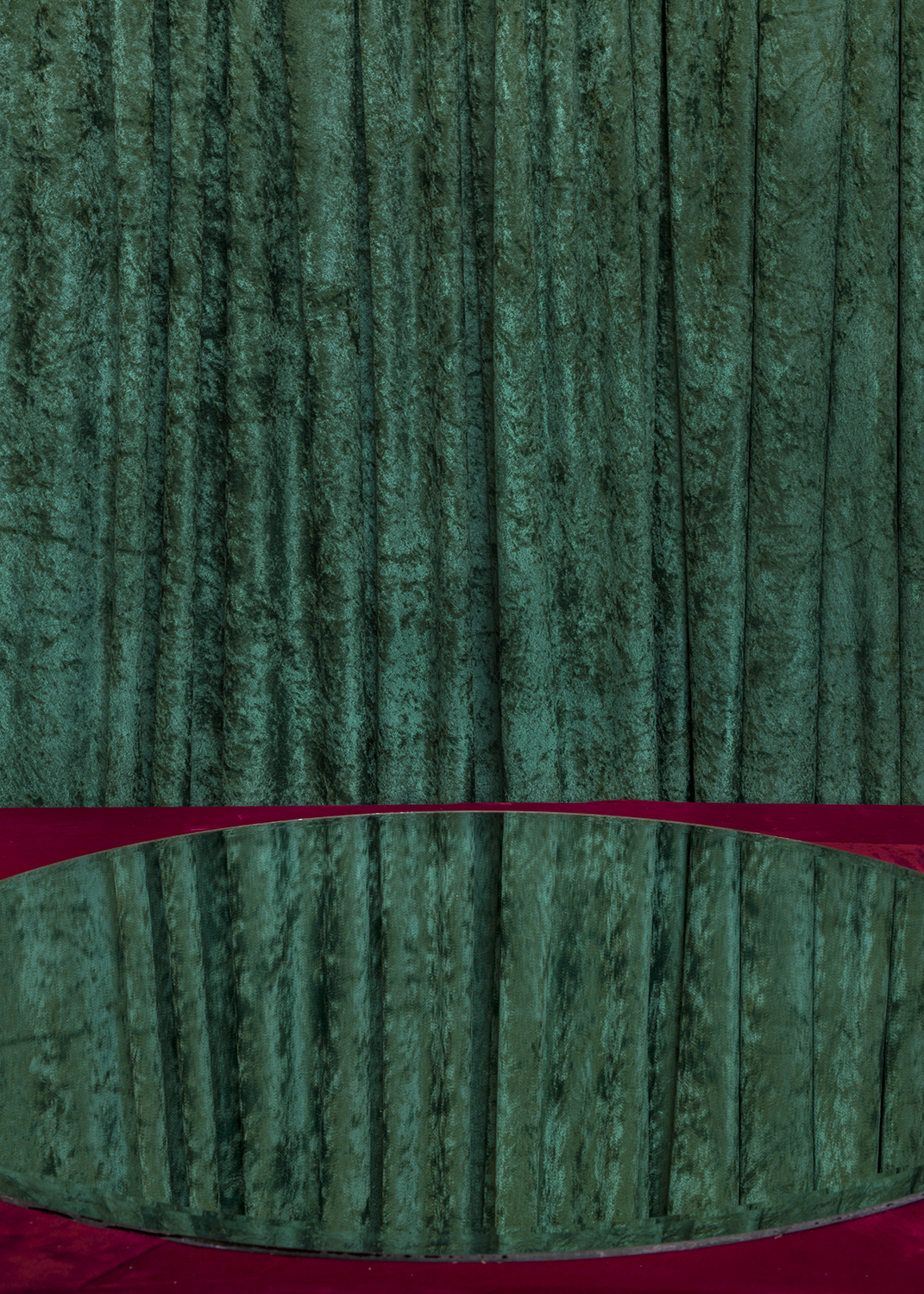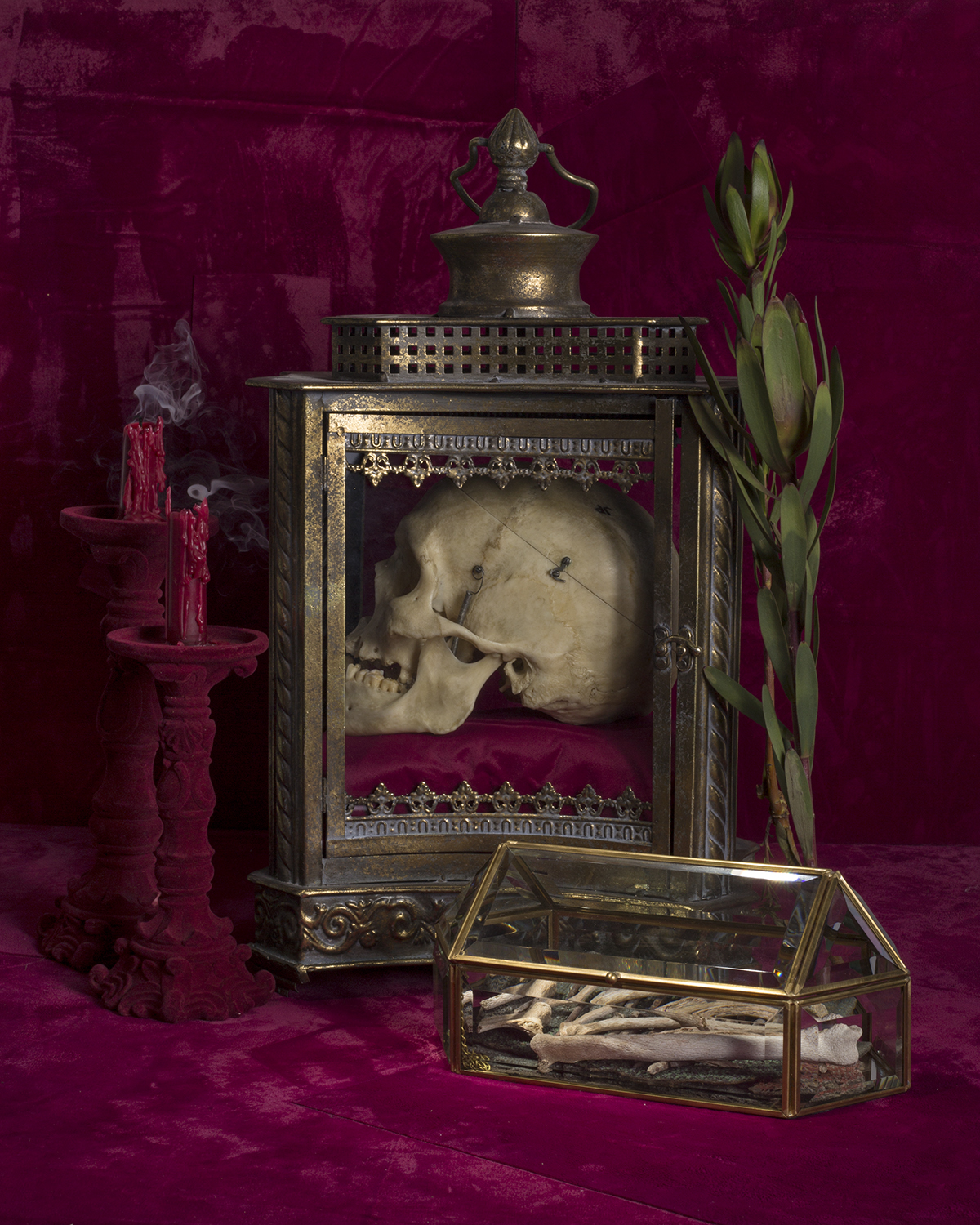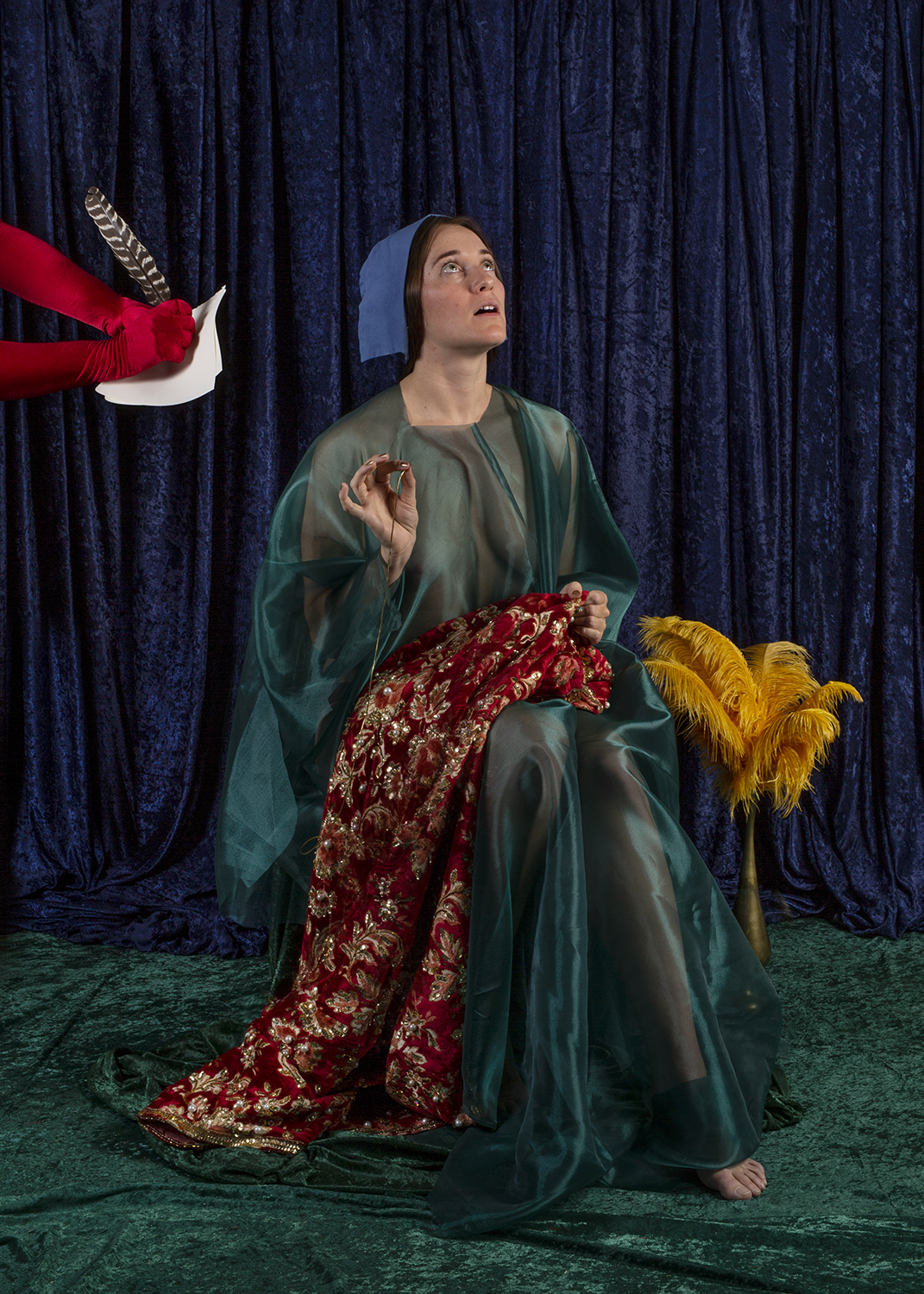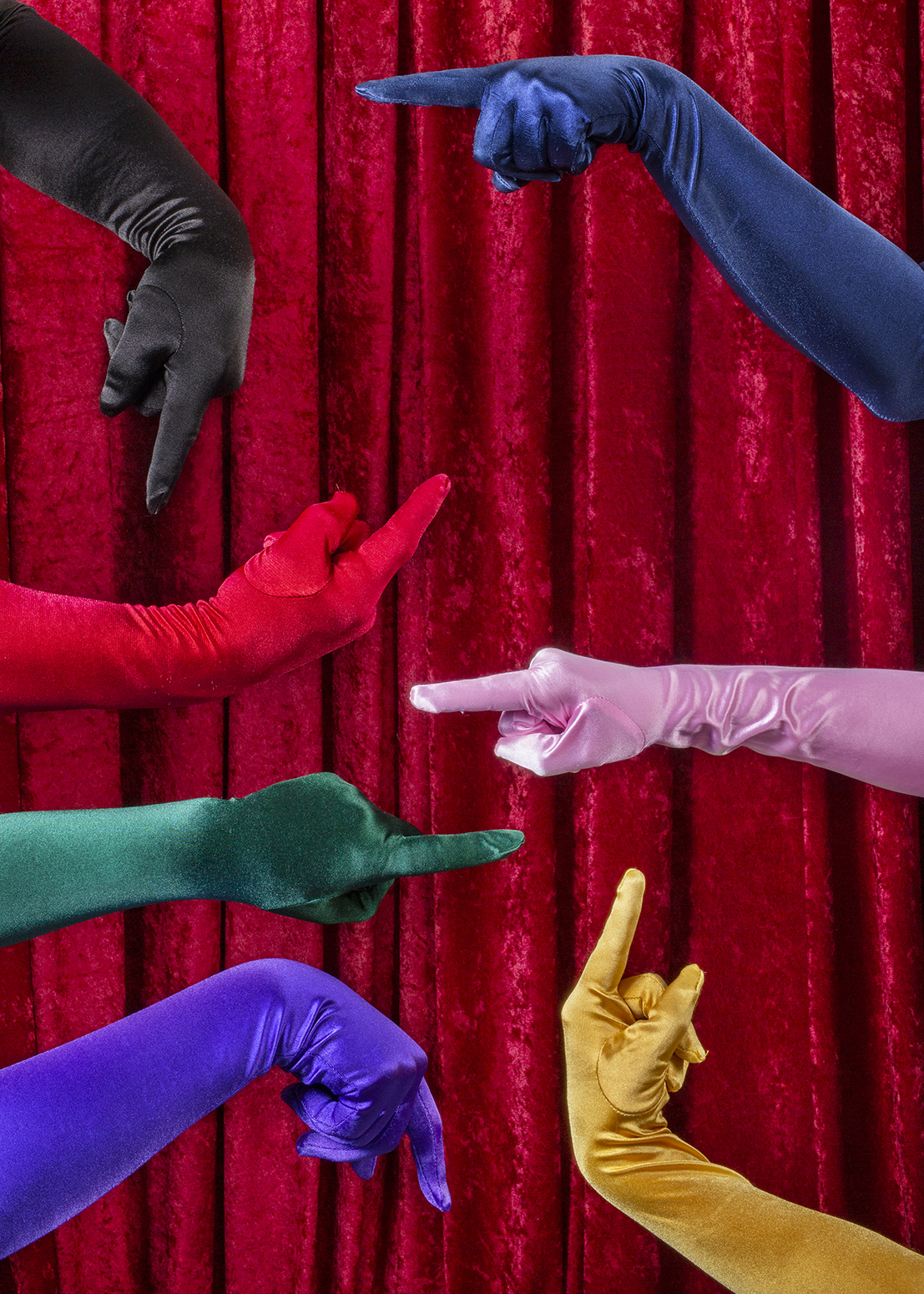Q&A: rachel stern
By Jessica Baran | December 6, 2018
Rachel Stern creates elaborate staged photographs that transform toss-away, dollar-store materials into neo-Baroque tableaux. Situating friends, family and other close acquaintances amid lushly arranged studio contexts, her images function on both direct and allegorical levels, evoking narratives that feel at once wholly contemporary and pulled from elusive historical depths. Drawing from literary sources as well as the worlds of drag and photographic Pictorialism, her work feels at once carefully researched and blithely of-the-moment — enveloping the viewer in a total world and logic steeped in the elemental pleasures of color, texture, bling and material and figurative beauty. Stern received her BFA in Photography and the History of Art and Visual Culture from the Rhode Island School of Art and her MFA in Visual Art from Columbia University. Her work has been featured in BOMB, ArtFCity, Hyperallergic, and Matte Magazine; and has been exhibited at Columbia University and Brandeis University, among other venues. She currently lives in Philadelphia.
Jessica Baran: Hi Rachel! Thanks so much for taking the time to talk with me about your work and practice; I’m so happy to have this opportunity to connect with you again! Can we start with having you speak about how you arrived at photography and your current mode of working -- including where you’re from, where you studied and any key influences that helped shape your thinking? This will help familiarize those who do not know your work and also relate to some other questions I have for you later on.
Rachel Stern: Hi Jessica - always so good to chat with you. I am so grateful for your support and interest in my work. I grew up mostly in Massachusetts in a tight knit family of four siblings and two truly wonderful parents. We lived at the tip of a little peninsula that was populated mostly by seasonal residents and thus incredibly private for most of the year. I describe this because I feel our physical position on the tip of an only occasionally occupied spit of land is a good image for how I understood my social world as well. I was never lonely, so I don’t mean isolated in the negative sense of the word, but we were sort of out there on our own. This position was echoed in school and in little league or ballet where it was always quietly clear that we represented an ethnic minority as Jews and a political minority as leftists. I don’t mean to paint a dire picture: we were very jolly children with friends and community and only rarely encountered overt anti-Semitism. We drove to Hebrew School an hour or so away on Cape Cod where we had cousins and generally found our way quite easily. And I must stress that the society of the Stern siblings alone (five years only between the youngest and the oldest of us four) was strong and complex enough to fill any childhood. So it was there on that New England peninsula that I did most of my growing up and there, naturally, that I became a photographer.
The walls of my parent’s home are filled with black and white photographs. Some are art and some are family photographs and some of course walk the line. Though my parents are both doctors, they have always been people who make and look at art. My mom taught batik at her summer camp and hand painted all our birthday decorations, and my father attended classes at the Art institute of Chicago through high school. There are other artists in my family, too. My grandmother Naomi continues to be a formidable ceramic sculptor and folk artist into her 89th year. I had two amateur photographers for grandfathers and several close family friends who have made their lives taking pictures in various ways. My aunts are architects, documentary film makers, and dancers (even ice dancers)! My first cameras, and many that I still use today, were hand-me-downs from these ancestors and my initial photographic education took place on the walls of my house. In the earliest picture I have of myself holding a camera, I am six or seven years old standing in my mother’s garden with an indefatigable grin. I have been photographing seriously ever since.
Bread and Roses, 2018
And so despite my boasting of goals to become an ACLU lawyer it was no surprise to anyone when I enrolled at the Rhode Island School of Design and began my formal artistic education. There, in the lineage of Harry Callahan, Aaron Siskind, Francesca Woodman, and so many others I so admire, I studied under inspiring teachers and among the most compelling peers. My mentors Henry Horenstein, Steve Smith, and Michael Bühler-Rose made up something like the cast of the Wizard of Oz in the facets of support and inspiration they offered me. Henry taught us to love photography. To love the world. To do things out of love. I always fear that the word love is so big that it sounds flat, but I want to underscore just how essential it is as a principal. This idea of working out of a place of love remains in many ways a central tenet of my practice. From Steve we learned the seriousness of craft and the potentials of the medium of photography at large. RISD is a craft place and for this I will always be grateful. I know how to make things and I understand that the making and the thinking are one gesture. As Cage and Kent outline in their famous rules, “It is the people who do all of the work all of the time who eventually catch on to things.” From Michael I learned how to have a real independent and focused practice as an artist. He imparted the importance that artists use our experiences and understandings to talk about the world instead of asking the world to think about us through our art. This is the practical lesson that allowed me to leave school understating the potentiation and the responsibility of applying the skills I had acquired.
While at RISD I also studied art history and was a teaching assistant to Graham Day Guerra’s drawing classes. Both experiences continue to feed my understanding of photography in the expanded field and within a more holistic context. I can’t express fully how valuable my experience at RISD was and how much my teachers and peers there shaped my life. In awe of my faculty, I resolved to one day also assume the role of educator. I continue to collaborate with those peers. I left RISD a primarily black and white film photographer. I loved Weegee, Claude Cahun, Peter Hujar, Bras,sai and Sudek among so many others. I wanted to express through my photographs just how in awe I was of the whole world. I wanted also to express just how complicated awe can be. Through a studio visit with Humble Arts Foundation curator Amani Olu, I was prompted to take these ideas into the studio and point a little more directly. I was very taken with this new permission to be direct and the power that the studio gave me to suit that mode. At the same time I was teaching high school in underserved Rhode Island public schools. I began to focus on the idea of using the material culture that was available to us in suburban Rhode Island to create images which discuss and re-imagine all those cultural structures which inspire both admiration and fear (this is to say awe). This was the inception of my practice as it stands today. I attended the Skowhegan School for Painting and Sculpture in 2014 and graduated with my MFA in Visual Arts from Columbia University in 2016. My work centers around this: I love photography because it is the task of looking at the world. It is about looking at the world critically and framing it for the benefit of our larger social, political and emotional conversation. It exists at the nexus of beauty and power. What could be a more compelling pursuit?
Truth and Spectral Evidence, 2018
JB: Your new exhibition More Weight, which just closed at Brandeis University’s Kniznick Gallery, takes Arthur Miller’s canonical play The Crucible as its starting point. Like its source, the exhibit is an incredibly timely body of work that took on added prescience when the Kavanaugh trial occurred, during the show’s run. You have a pretty amazing connection to Miller and I’d love for you to describe that as well as what you feel the show is about and what drove you to create it.
RS: I remember speaking with the Kniznick Gallery curator Susan Metrician during a pre-show visit in March and discussing the potential for a dramatic fall in the Court coinciding with the run of the show. Never in our wildest dreams did we imagine what was to come. The particular cruelty in the treatment of Dr. Ford in the wake of Anita Hill and the energy that Kavanaugh’s confirmation gave to the right have shaken and disillusioned me in a new and deeper way. I am writing this now a few days after The Tree of Life massacre in Pittsburgh. It was the deadliest antisemitic attack in our nation’s history. In the same week two black shoppers were murdered at a Kroger in Tennessee and when the gunman was confronted with “don’t shoot” by an armed white civilian he responded “whites don’t kill whites.” This has all (always) been present here. And though Kavanaugh simply said “I like beer” and only implied and indicated in every possible way that he was a rabid chauvinist (this is to say unlike Trump who is actually using words like nationalist and globalist and invader and very fine people with no shyness or misdirection whatsoever), in my own psyche I mark a distinct change before and after Kavanaugh. So, though we can’t accuse him of directly emboldening these particular murders, I can accuse him and the Republicans on the Judiciary Committee and in the The Congress of seismically shifting my capacity to maintain hope that the people who perpetrate violence and hatred will be held accountable or that there is any core American ideal upheld enough to continue believing in. “America never was America to me.” Now in this moment the urgency that I felt to create the works in More Weight feel much more like dismay. “And yet I swear this oath— America will be!”
I teach photography at a few county colleges in New Jersey and because of that I feel a great responsibility to be as informed as I can be about the status of our nation and society. As I mentioned earlier, photography is the task of looking, so it is important that we bring the world with us to the studio and the classroom and that I, as the teacher, am as prepared as I can be to engage with whatever discussion of the world my students bring with them. I talk with my students about Provoke, the postwar Japanese photography movement, and I ask them to place themselves in those artists’ predicament: imagine two atomic bombs have been dropped on your country and you are a photographer; tomorrow morning you must wake up and go photograph. Where do you point your camera? When I first started asking this question it felt like a very dramatic and distant consideration but it has begun to feel less absurd each time I ask it. It was with the logic of Provoke that I began to produce More Weight.
The work might best be described as an emotional document of my experience as a subject of the law in this utterly dismaying moment. In my work and in my life at large I turn to literature and lore as a foil for my ideas and understandings of the world. As we have watched our courts become increasingly central in our political discourse, as fake news and witch hunts flood our social landscape, I naturally began thinking about Arthur Miller’s The Crucible. As you mentioned, I have this funny connection to Miller. He was, in some way, a distant cousin of mine. Distant enough that I can claim no real relation but close enough that I have clear memories of his sister, the actress Joan Copeland, holding court at family gatherings, reminiscing about visits to Calder’s studio or about how Kermit (the other brother) was the only of the three who was really worth his stuff. What has ended up being my most relevant connection to Miller is the kinship I feel for his immigrant and Jewish perspective on the American Colonial story of the witch trials in Salem. It resonates both with my experience as a New England Jew and with my experience as a hopeless and hapless (but complicit) subject of the law. Miller’s play so delicately displays this balance where the law becomes an entirely social expression of power, desire, and fear. He has responded to an event wherein the accusers become the accused, any sense of benevolence from the government is abandoned, and social complacency with terror rules the day. More Weight is my third echo of this particular limbo (or is it just hell?). Thinking about the symbols of the law and its social location, the work bounces from Colonial Salem to Trump press conferences and from the Korean DMZ to illuminated manuscripts. Hopefully it serves as some record of the experience of being a citizen during this social crisis playing out in the courts just as Miller looked to Salem to discuss the absurd corruption and malicious threat of the House Un-American Activities Committee. This is the best measure of success I can imagine for the work — that like Miller’s play it can hold both a complexity of narrative and a certainty in its observation of a real threat.
Diplomacy, 2018
JB: I love that you’ve used “queerwashing” in previous interviews to describe how your work operates, especially in relation to what are often historical literary sources. Could you talk about how and why this term fits with your practice? I can’t help but also align what you do – in its totalizing, highly staged nature – to the phrase “queer worldmaking,” which Laurent Berland and Michael Warner coined as a way to identify certain civic practices in which queer communities must literally construct for themselves worlds in which they can exist. I wonder if this also speaks to you.
RS: I consider my work to come from two places. Most immediately it has to come from my earnest self – those things that I am interested in, care about, or, as Henry taught us at RISD, that I love. This becomes the content of my work – what we actually look at. Secondly, it comes from my intellect and my conscience. This is the part of my work that is goal-oriented, that is aware of the history of art and the current status of visual culture. This is the part that wants to say something concrete and critical. My idea of queer-washing enters at the intersection of these two conceptual fronts. It is a means to reconcile a deep admiration for a human history of art with the inevitable social inequities and real human pain which is so inexorably linked to that history. How can I be an artist who is inspired by the very systems which built the world that oppresses and demeans us? What does it mean to love an artwork which we know was made out of suffering? (This particular question has become even more complex and pressing in the era of #MeToo.) So to this idea of queer world-building I would consider my notion of queer-washing to be an offshoot where, rather than creating a new queer space (or potentially as a means to create a new queer space), I am sifting through our existing archives and culling from them the lost heroes and opportunities to reinterpret or refocus our understandings of what and how humans have made things. How, for example, can we celebrate Rococo, which influenced so much of aesthetic culture, with full knowledge of the rabid oppression of the people by the Seventeenth Century French court? What does it mean to revel in beauty which was built on the breaking backs of the peasants? In an intersectional world the wellbeing of the worker is analogous to the wellbeing of the queer – our struggles are one and the same. And so while I certainly cannot condemn the exquisite beauty of the architecture and object and fashion and painting that came out of the French court I also cannot simply and cleanly enjoy it. So as I sift through my penchant for literature and history I am always wondering about the potential to expose and redirect narratives. I want to force out the full scope of what actually happened and then (queer-wash) take from it what I want, what we deserve and allow myself to own that beauty. To say it another way: feudalism has fallen and though we remain in a capitalist dystopia in order to move forward to socialism we need to be able to be happy, to experience beauty, and to put on hands on those things which, born of our means of production, serve those that oppress us. This is my idea of queer-washing: to be politically persistent in our consumption of our own culture.
JB: Another related synonym for all of this could be “drag.” Meaning, in your highly inventive and immersive studio practice, you essentially queer American (mostly heteronormative) canonical literature. You’ve also photographed drag queens in your work. Can you talk a little bit more about your relationship to drag and how it figures in your work? I’m also wondering if you have a conscious interest in redefining the traditional sense of “American.”
RS: For me the really beautiful part of drag is the symbolic relationship between fact and fiction and between audience and artist. The magic of drag is a complicit and witting understanding of artifice. Like George Mieles’ films in which we are convinced of the magic of his special effects in no small part because they reveal a genius use of the tool that is a camera, drag for me has been a huge inspiration in my understating of the potential of curated reality and the political importance of immediacy. That humans will use fantasy to supplant or augment the crush of real life is a thing of real wonder. This relates back to the idea of queer world-building that you brought up. It is politically urgent that despite living under capitalism we claim our own opportunities for beauty, pleasure, and the powers that accompany those experiences. Drag is urgency.
This question about re-defining what it is to be American is a really interesting one. Maybe this is idealistic but I think the whole concept of re-defining or re-inventing is central to a fundamental American identity. I tend to want to look the beast in the mouth rather than look away and so my immediate reaction is to say no, I don’t hope to re-define or drag America so much as I hope to show something of what America is right now. That being said I also believe that we, all of us, are re-shaping our society in every gesture and facet of our lives. So long as we protect our human rights we will continue to do just that throughout our cities and across generations.
Justice in Repose, 2018
JB: And to follow that, I’d love to hear about how and why you select your subjects.
RS: Selecting subjects is such a critical element of the work. For me, photographing is an honorific form. That is to say that I tend to point my camera toward things I hope to memorialize – usually out of love, however complex. This means my subjects tend to be friends and family – the people that I love. Like the great Pictorial portraitist Julia Margaret Cameron, I make a dual portrait of my subjects, asking them to be both themselves and some allegorical or illustrative character. In the case of More Weight, which discusses the court and the law, I thought very critically about who would occupy my cast of characters. American law is nothing if not a tragedy of race, sex, class, gender, and religion. We know that it affects and is affected by entirely different parts of the population in dramatically different ways. Because of this the ways in which I represent the law through bodies becomes very charged and critically important. As I sat with these questions I decided that I could not justify the tokenism of casting specific bodies into the work to represent a particular class or group and so instead I chose to photograph my friends and family as they pass through my studio during the period I worked on the project. There is thus a limited representation of the real body politic which comprises the actual functional and expansive law. My hope is that this limitation would expose some of the fallacy of ideas like “a jury of our peers” in a country where we know that juries are overwhelmingly white and so impossibly fulfilling that charter. The faces found in More Weight are the faces of the people who I have been with and talked with about each twist and turn of the court and each protection and pitfall we encounter in the law.
JB: More often than not I hear artists say that they’d never want to teach – but you not only love teaching, you see it as a necessary part of your creative practice. Could you talk about this aspect of your practice? I know it relates in part to your rich family legacy of activist educators as well as your desire to democratize art in general, but I’m also interested in how, say, your students influence your work directly.
RS: It is true that I not only love to teach, but I consider it a central park of my practice as an artist. My history in the classroom has typically been in less affluent institution with limited resources. As is the case with most students and people, if given the chance, I have been able to work with spectacularly brilliant, wonderful, creative, and complex students. Here is the thing that is incredible about my job: I get paid (albeit a relatively tiny sum) to go and discuss the meaning and potentials of photography and ideas with an ever changing group of inquisitive and energetic young minds. My students are constantly making strange photographs, discussing new photographers, and filtering their understandings through surprising influences. I get to be the sounding board and contextual guide for those explorations. This semester alone my students are making work about their family businesses, the loss of a child, their HIV-positive status, community churches and the no less important or grave status of being a young adult in New Jersey in 2018. When they embark on these projects they are undertaking the most serious activity – they are critically engaging in the making of our historical and emotional record. They are doing hard work, real work. This is among the most motivating factors in my studio. If I am asking my class to undertake such labor on a weekly or daily basis, then I owe them the same level of labor and consideration in my own practice. This is the least I can do in terms of preparation for class – to undertake the same task I ask of my students and to remain constantly engaged in the quest, cost, and experience of photographing. I think, for example, of my student Mel to whom I had mentioned a love I was developing for bridges and in particular one I passed on my commute to class. In response and without hesitation she asked not if but when I planned to stop and photograph the bridge. I came back the next week with the film exposed and ready to process. I think without Mel I would have just continued to drive past the bridge with admiration and never taken my own wonder seriously enough to stop and make the work. So many ideas would have withered without the motivation and guidance of my students.
You mention my family history so I will add in conclusion that my grandparents who were immigrants and radicals began their adult lives organizing unions in Gary, Indiana steel mills and concluded their lives as teachers, something they and I consider an extension of their political project. I don’t mean to imply that I am using my role as an educator to deliver political messages, but that teaching itself is political. Especially in photography class when the whole world is on the table (or the critique wall as it were), we must discuss the status of the world in earnest.
The Letter of the Law, 2018
JB: Your practice is actually incredibly diverse. We’re mostly focusing here on your photography, but you’ve also curated exhibitions and have done shows composed entirely of sculpture. Additionally, you have a non-studio-based, black and white photographic practice. How do all of these strands connect in your mind?
RS: Art school 101 is the Bauhausian doctrine that form fits function. Of course this is a design principle that has a strong physical logic, but it is also an essential conceptual directive. Make the work the right way for the idea rather than working in the ways you like to work. This means shooting black and white film (something that I love to do) only when there is conceptual grounds to do so. In 2018, it is an antique process or even worse, a digital filter often used as shorthand for nostalgia or to imply and enter into a certain photographic discourse. This means that for most photographs it is a form that does not logically fit the required function – it isn’t the most immediate means of producing an image. This constraint allows me to then use black and white film on specific projects where the attributes both poetic and physical support, deepen, and complicate the images themselves. For example, in my photographs of cemeteries, where stone is carved and left in place of a monument, I find a poetic connection to the chemical process of shooting and exposing film – etching or carving an image. It is this same philosophy which leads me to curate or sculpt or make installations – considering first what is the best format for whatever it is that I am thinking and feeling
Curation is something I really think of as a gift. When photographing, I often feel like I am shopping. Moving through the world with an “oh I’ll take that” attitude. Curation feels just the same. It is a platform from which I can ask for the things that I want and cull them together to create a display which satisfies my specific desires. It makes sense then that I typically see curation as a form of asking a question. I think about something I am grappling with in my own practice and then turn to artists whom I admire and ask their work to enter the conversation in trying to solve that problem. This is to say that like photography, sculpture, or installation, curation is something I turn to when it is the most direct means of engagement on a given topic or idea.
JB: What kind of equipment do you use when you shoot?
RS: In the studio I shoot with a Canon digital camera and a Sigma lens. I use AlienBee strobes with soft boxes and two or three lights in a set. My typical lighting technique is to flood with even light: a sort of non-lighting so that the drama is entirely symbol-based and everything is visually available. I shoot Ilford HP5 Plus 400 and Delta 3200 medium format film on my Mamiya 7 when in cemeteries and elsewhere. My props are an archive which has origins in my childhood dress-up box, strip malls, thrift stores, and party depots. I love to work with plastic, brass, velour, and other proxy luxury materials.
The Accord, 2018
JB: Seeing the connection between your studio practice, object-making and curating – as well as your penchant for narrative and portraiture – led me to think that your next step could be film-making. I know we’ve talked about this a little bit, but I’d love to hear how this actually might be a future direction for you.
RS: Oh yes. Movies! For me the cinema is church and films are the highest art form. It is an everything at once medium and I am a maximalist so we make a good pair. Unfortunately, I am also a person who, like many of us, is too oft governed by fear. I have written and abandoned more films that I can list. I have actually shot and abandoned one project for fear of editing – a shame because I think the content is actually pretty good. I am finally, I believe, at the middle of the beginning of a serious and accomplishable project. One for which I am willing and able to face my fears. The script is currently called “A Day in Allegory” although I expect that to change. The piece feels more like a play than a movie in stylization and outlines twenty five hours in the lives of a group of workers. The arc of the day is structured as an allegory for the Jacobin philosophy of revolution – an insurgent second wave in the French Revolution, which was inspiration for both the Bolsheviks and the Haitians. This particular model of revolution – a phoenix – is my most urgent sense of hope. It it is something that I feel we must understand, internalize, and prepare for if we hope to see our way out of the violent capitalism we all suffer. My brother who is a union organizer and leader of the Democratic Socialists of America has served as political advisor and has helped me with the research and poetic structure of the script. In the story labor is intensified, workers are abused, beauty is always being smuggled and secreted, and the momentum and outcomes of revolution appear at first toothless and lame. In the twenty fifth hour as my narrative ends we see the second wave, the Jacobin insurgence, begin. My current stumbling block is the unfortunate reality that a film about solidarity needs a communal body – lots of actors who all deserve fair pay for their labor. This is daunting for me since my studio practice has always been so solitary and shoe-string-budget. So, if anyone out there reading this wants to fund a film project, I need a budget!
JB: You described the function of witches really beautifully in one of your interviews – how they’re particularly appealing to us right now because they are capable of occupying so many cultural roles at once. And in a moment when it’s especially urgent to be cognizant of so many intersecting subjectivities, witches really do seem like the kind of “progressives” we need. All to say, I think you are a bit of a witch in the many strands you’re able to connect to your work – and I mean this as the highest compliment. What do you expect from an artist-witch these days? Or, maybe more directly, who are you hoping to reach with your work? Or, who else do you think is a witch?
RS: Witches are really such a compelling topic. No wonder that we are enjoying the reboot of Charmed and Sabina (albeit somewhat homophobic and pretty disappointing in its feminist agenda) alongside an endless stream of Esty stores and Instagram accounts which solidify our understanding that the witch is inspiring people and especially young women. If you research the witch as both a character and an actual figure in society it is astounding (in that “it was right there in front of you the whole time” sort of a way) to recognize how she is a figure which emerges as a chauvinist backlash in defense of the capitalist (or federalist or imperialist or fascist) necessity for the patriarchy. When we look at the quintessential traits of the witch and compare them with structures of labor, we see how the midwife threatens sexual repression, the working woman threatens the confining structure of the home, and the single woman who does not procreate threatens the entire structure of society. Silvia Federici outlines this history in her compelling book Caliban and the Witch and walks us through the use of chauvinism as necessary to the transition from feudalism to capitalism. Women pose a unique threat and that threat has been named Witch and that word Witch has been used as permission to implement that threat. Or to try. So when I think about why the witch is so appealing to us today it is because we are at one of those crossroads where society needs to pick a way out. A German woman, Clara Zetkin, in 1923 presented a comprehensive report of fascism, describing how it can rise, how it functions, and importantly how it can be avoided. Her prescient thoughts were not enough to sway the public in Germany to squash what grew to be the Holocaust, but if you want to know a witch that is one for sure. In some ways witchcraft is an unremarkable magic. The witch is one who, for nothing more than being a woman and having eyes open to what that means, is able to imagine and then to build the structures that get us out. The structures that set us free. I don’t think the witch matters because she is an escape into fantasy, I think the witch matters because she is a practical guide to revolution.






